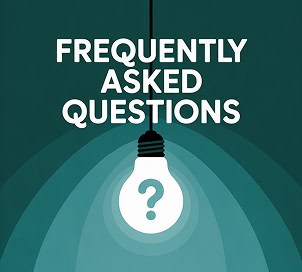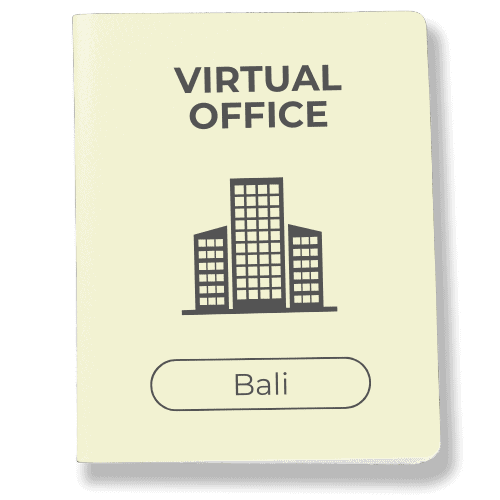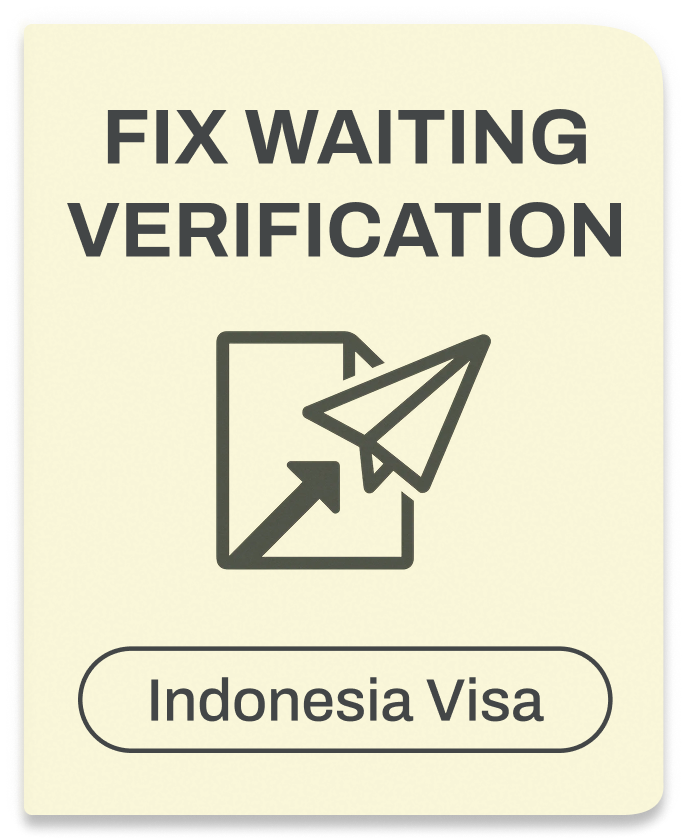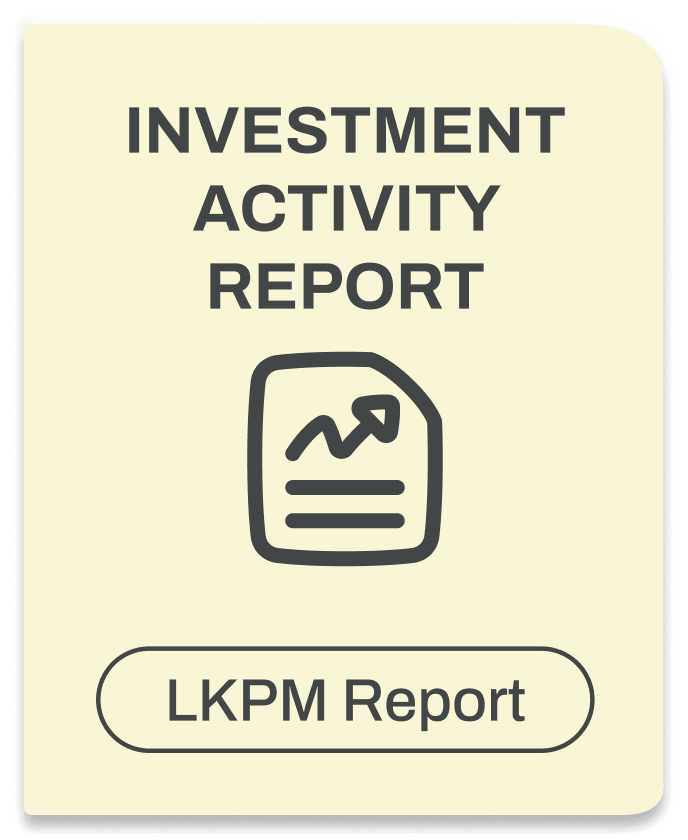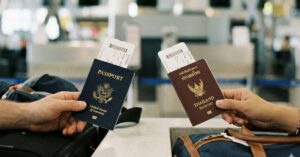Indonesia’s Visa on Arrival Mistakes (And How to Avoid Them)
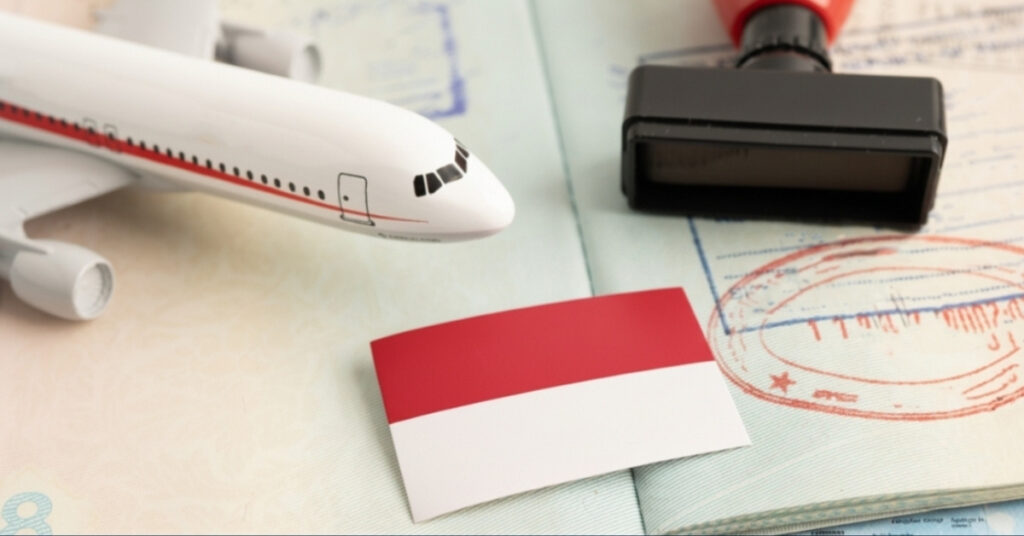
Indonesia’s visa on arrival process is pretty straightforward when you know what you’re doing. But here’s the thing: immigration rules change frequently, and there’s a lot of bad advice floating around on TikTok and in Facebook travel groups. This guide is different. It’s based on actual regulations from the Directorate General of Immigration and real cases from foreigners who’ve been there, and it’s written in plain English for 2025.
Quick disclaimer: Always check official sources like evisa.imigrasi.go.id and imigrasi.go.id before you fly. Or, chat with us at visa-indonesia.com for a fast answer. Rules can shift, and you want the latest info straight from immigration.
Understanding Indonesia Visa on Arrival: Immigration Rules for 2025
Let’s clear up the confusion before we get into the most common reasons travelers run into trouble.
Indonesia’s visa on arrival (VOA) is for short visits. You can get the regular VOA when you arrive, or you can apply for an official Indonesian e visa online before your trip. Not every nationality qualifies, so you need to verify that your passport country makes the cut on the official list.
You can only enter Indonesia with a VOA at approved entry points. That means certain airports and seaports, not every tiny border crossing. The initial stay is 30 days. You can get it extended once for another 30 days, giving you a total of 60 days max. Don’t confuse “validity” with “stay period.” The validity is your window to arrive in Indonesia. The stay period is how long you can actually be there.
What you need: a passport valid for at least six months past your entry date, proof you plan to leave Indonesia (like a return ticket), and payment for the visa fee. If you’re doing the electronic visa route, use only the official website. You’ll also need to complete the All Indonesia arrival card on the approved online platform. Double-check what’s required right before you travel because these digital requirements keep evolving.
One more thing: this visit visa is not a work visa. It’s also not for foreigners who intend to stay long-term. It’s for tourism, visiting family, and similar short-term reasons.
Now, let’s go through the mistakes people keep making with the Indonesian visa on arrival.
Mistake #1: Assuming Everyone Gets a Visa on Arrival

A lot of travelers just assume they’re good to go without verifying if their nationality is actually eligible. Big mistake. Airlines can deny you boarding. Immigration officers can refuse you entry. It doesn’t matter how many Instagram posts you’ve seen about Bali. If your passport isn’t on the list, you’re not getting a visa on arrival.
Action: Verify your nationality on the official list before you book anything. Not after. Before. This is one of the most common reasons for visa rejection at the airport. You can check your passport eligibility for VoA through our Visa Finder.
Mistake #2: Confusing 30 Days, 60 Days, and Visa Validity

This trips up many foreigners all the time. Here’s what you need to know: your initial stay is 30 days. You can extend it once for another 30 days. That’s it. Total maximum: 60 days.
But then there’s something called “validity” on the electronic visa. That’s not how long you can stay. That’s your window, actually, to enter the country. Let’s say you apply for an e-visa on January 1st, and it’s valid for 90 days. That means you need to arrive in Indonesia by March 31st. Once you arrive on, say, February 10th, your 30-day stay starts counting from that date, not from when you applied.
Here’s a real example: You get your e-visa on March 1st with 90-day validity. You fly in on March 20th. Your 30 days of stay run from March 20th to April 18th. You can get it extended before April 18th, giving you until May 18th total. Get it?
Bottom line: If your plan needs 61+ days, you probably need a different visa type, not a VOA.
Mistake #3: Booking a 2–3 Month Trip on a 30-Day Plan

People do this all the time. They book six or eight weeks in Bali, thinking, “I’ll just figure out the visa process when I get there.” Bad idea.
Extensions have cutoffs. The immigration office closes for holidays. Their systems can have tech issues. You might face consequences if you mess it up. There’s also the risk you won’t be able to extend at all if something goes wrong with your timing or the required documents.
Quick decision: If your trip might last more than 60 days, plan for a different visa from the start. The most popular tourist visa for more than 60 days is the tourist visa (C1). Don’t gamble on an extension working out perfectly.
Mistake #4: Using the Wrong Visa Type for Work and Business Activities

This is where travelers get themselves into serious legal issues. VOA is not for work. Period. It’s also not for volunteering, creating content for money, performing, teaching, or running events. Using the wrong visa type here can lead to even deportation.
“But I’m just working remotely for my home country company!” Doesn’t matter. That’s still considered a work activity on Indonesian soil. “I’m just filming some YouTube videos!” If you’re getting paid for it, it’s work. “I’m volunteering at a hostel for free accommodation!” Still counts.
The consequences aren’t small. You can be refused entry. Your visa can get canceled while you’re there. You can be deported and get a black mark on your record. Immigration enforcement has gotten stricter in recent years. Foreign workers need proper business visas or work permits, not a tourist visa.
If you need to work, attend business meetings, or do anything that’s not pure tourism or visiting, you need the correct visa from one of the other visa categories. Don’t risk it.
Mistake #5: Ignoring Passport Damage, Validity & Onward Ticket Rules

Airlines and immigration will turn you away for these issues all the time. Your passport needs at least six months of validity left from your entry date. If it expires in five months, you’re not getting on the plane. This is one of the most common reasons for visa rejection.
Damage matters too. If your passport’s data page is torn, water-damaged, or the information is hard to read, that’s a problem. Immigration officers need to scan your passport clearly. Even small tears can cause rejection.
And yes, you need proof you intend to leave Indonesia. A return ticket, an onward ticket to another country, whatever. Just have documents showing you’re not planning to overstay.
Quick Passport Checklist
- Valid for 6+ months from your arrival date
- At least two blank pages for stamps
- No tears, stains, or damage on the photo/data page
- Photo still looks like you (if it’s 10 years old and you’ve aged a lot, consider renewing)
- Passport numbers are clearly readable
Onward Ticket Options
You can book a fully refundable ticket, use a cheap budget airline ticket to a neighboring country, or use a temporary ticket service. Just make sure you have proof to show if asked.
Mistake #6: Falling for Fake e-VOA Websites & Sketchy Visa Agents

Scam websites are everywhere right now. They copy the official Indonesian immigration branding. They look legit. Some visa agents charge hidden fees that go straight into someone’s pocket instead of to the government. These fake sites are not the official sources you need.
Here’s how to spot the fakes: The domain isn’t .go.id. They charge hidden fees or extra “processing” money with no transparency. They’re vague about processing times. They ask for weird payment methods.
Use only the official e-visa portal. Check the URL carefully. The real government sites end in .go.id. Don’t trust the first Google result. Don’t trust Facebook ads. Go directly to evisa.imigrasi.go.id or check the official immigration pages for the current link.
Random visa agents messaging you on social media? Nope. Websites promising “guaranteed approval in 1 hour”? Nope. Stick with official sources. Always take advice and service from a trustworthy Indonesian visa agent like visa-indonesia.com.
Mistake #7: Messing Up e-VOA Details (Name, Passport Number, Dates)

Incorrect documentation is one of the top causes of visa rejection. A typo can invalidate your entire visa. And in most cases, there are no refunds. You’d have to apply again and pay again.
Your name needs to match your passport exactly. Not a nickname, not a shortened version. Exactly as it appears. Your passport numbers can’t have typos. One wrong digit and you’re done. Your dates need to be accurate, especially your intended arrival date range. These mistakes on the form can cause major problems.
Mini Double-Check List
- First name, middle name, and last name match the passport perfectly
- Passport numbers are 100% correct
- Expiry date on the passport is entered correctly
- Arrival date matches your actual travel plans
- Email address is typed correctly (you’ll need the confirmation)
- Double-check all documents before submitting
Take your time. Triple-check everything before you submit. It’s worth the extra two minutes to avoid incorrect documentation issues.
Mistake #8: Waiting Too Long to Extend (or Thinking You Can Do It “Anytime”)
You can’t extend your VOA whenever you feel like it. You need to start the visa process at the immigration office before your current stay permit expires. That’s the deadline. Miss it, and you’re overstaying.
Overstaying isn’t just a fine you can casually pay. It’s a violation. You’ll face daily fines. In serious cases, you risk detention or even deportation. Even if you pay the fines and leave, it goes on your record as a black mark.
Extension timeline: Start your extension at least 7 days before your 30 days are up. Don’t wait until day 29. Set reminders on your phone so you don’t forget. Give yourself buffer time for appointments, paperwork processing, and any hiccups.
Some immigration offices get backed up. Some have limited appointment slots. Don’t assume you can walk in on day 28 and walk out with an extension. Many expats have learned this the hard way.
Mistake #9: Thinking Paying the Overstay Fine Fixes Everything

Here’s the myth: “If I overstay a few days, I’ll just pay the fines at the airport and it’s all good.” Not true.
Paying the fines doesn’t guarantee you can re-enter Indonesia easily. It doesn’t erase the violation from your record. Immigration can interview you about it on future entries. They can deny you entry. In some cases, you can face deportation or entry bans.
The money you pay is a penalty, not a free pass. It means you broke the regulations. Officials have full discretion to decide what happens next. Some people pay and leave without issues. Others get banned for years. Why risk a black mark on your record?
If you know you need more time, extend legally. If you’ve already overstayed accidentally, deal with it properly through official channels, not by hoping the payment makes it all go away. The consequences can include even deportation in serious cases.
Mistake #10: Not Checking Latest Rule Changes (Entry Apps, Levy, Ports, E-Gates)

Indonesia’s immigration rules change frequently. Eligible countries get added or removed. Fees change. New requirements pop up, like mandatory digital forms or tourism levies. E-gates get rolled out at more airports. Entry points update which visas they accept.
A blog post from 2022 might be totally wrong in 2025. That viral TikTok from six months ago? It could be outdated advice.
What to do: Check official sources 1–2 weeks before your departure. Look at evisa.imigrasi.go.id and imigrasi.go.id from the Directorate General of Immigration. See what’s current. Don’t rely on old forum posts or random travel influencer advice that might not be accurate anymore.
Things that have changed in recent years: digital arrival card requirements, which ports offer VOA, fee amounts, and extension procedures. These aren’t small details. They’re the difference between a smooth entry and getting turned away.
Mistake #11: Trusting Social Media Rumors Over Official & Expert Guidance

Facebook travel groups can be helpful for restaurant recommendations and beach tips. But they’re not authoritative official sources for visa regulations. Someone saying “my friend did this and it was fine” doesn’t mean it’s legal or that you’ll have the same experience.
Immigration officers have discretion. What worked for one traveler might not work for you. What one officer allows might get you denied by another. This is especially true for visa applications where enforcement varies.
Cross-check everything you read on social media with official sources from the Directorate General of Immigration. If you’re unsure, consult reputable visa service providers who have actual legal credentials, local presence in Indonesia, and current expertise. Look for licensed visa agents who cite official regulations and keep their information updated.
Your cousin’s TikTok from Bali isn’t legal advice. The random person in a Facebook group arguing about what they “heard” isn’t an expert. Bad advice can lead to visa rejection or worse. Protect yourself by going to real official sources.
When Visa on Arrival Is the Wrong Choice (And What to Use Instead)
Sometimes VOA just doesn’t fit your plan. Here’s when you need to look at other visa categories.
Staying 61–180 days for slow travel? You’ll need something like a tourist visa, which allows longer stays and multiple entries. VOA tops out at 60 days total, even with an extension.
Coming for business meetings, conferences, or site visits? You need a business visa. VOA isn’t meant for professional activities, even if you’re not getting paid by an Indonesian company. Using the wrong visa here can cause legal issues.
Remote working or digital nomad? The regulations around this are evolving, but standard VOA is risky for foreign workers. Indonesia has specific digital nomad visa options. Check what’s officially available for your situation.
Planning to stay long term, joining a family, studying, or taking a job? You need a social-cultural visa, a student visa, or a work permit visa, depending on your purpose. A tourist visa won’t cover any of these. Applicants for these visa types need to apply through Indonesian embassies in their home countries.
The key is matching your actual activities to the right visa type from the available visa categories. Using the wrong visa isn’t just inconvenient. It’s a violation that can get you deported and banned from Indonesia.
Safe VOA Plan: Pre-Flight Checklist (Save This Section)
Print this out or screenshot it. Run through it before you leave:
- Confirm eligibility. Your nationality is on the official VOA list, and VOA actually fits your trip purpose. Verify this information.
- Check your passport. Valid for 6+ months from entry date. At least two blank pages. No damage or tears. The photo is recognizable. Passport numbers are clearly readable.
- Book your onward ticket. Return flight, onward flight, whatever. Just have proof that you plan to leave Indonesia within your visa period.
- Use only official sites. If applying for an electronic visa, use the real government website with .go.id domain. Don’t fall for fake visa agents.
- Prepare payment. Know what payment methods are accepted at your arrival point if getting a VOA on arrival. Have backup payment ready. Watch out for hidden fees from unofficial sources.
- Save all documents. Screenshot or print your e-visa approval, arrival card confirmation, hotel bookings, travel insurance, everything. Keep both digital and paper copies of required documents.
- Set reminders. If you might extend, set reminders in your phone for at least 7 days before your initial 30 days expire. Don’t forget this step.
This checklist takes 15 minutes. It can save you from missing your flight or getting a visa rejection at immigration.
FAQs (Clear, Honest, Updated)
Can I work online for my foreign employer on a VOA?
No. Under Indonesian regulations, any work activity carried out while you are physically in Indonesia is supposed to be done on the correct work-authorized visa, regardless of where your employer is based or where your salary is paid.
What happens if my flight changes and I arrive 1–2 days outside my e-VOA window?
Your electronic visa has a validity window for entry. If you arrive outside that window, it’s not valid. You’d need to apply for a new e-visa with correct dates, or get a VOA on arrival if available at your entry point. This is why you should apply for an e-visa only when your travel dates are firm. Always double-check your dates on the form.
Do kids need VOA too?
Yes. Every person entering Indonesia needs their own visa, including infants and children. They need their own passport and their own VOA. The fee applies to minors just like adults. All visa applications require proper documents for children.
Is VOA available at my entry airport or port?
Not every entry point offers VOA. Major international airports like Jakarta, Bali, and Surabaya do. But smaller crossings and ports might not. Verify on the official list of VOA-eligible entry points from the Directorate General before you book your route into Indonesia.
How do I fix mistakes on my e-VOA?
In most cases, you can’t edit an electronic visa after it’s submitted. If you catch an error and it’s approved with incorrect documentation, you might need to apply again with correct details through online applications. That means paying again. Some minor discrepancies might be overlooked by immigration officers, but don’t count on it. The safest move is to double-check everything the first time, or apply for a new one if the mistake is significant. This is why it’s critical to verify all information before submitting the form.
Ready to Apply or Extend Your Visa?
Let our visa specialists handle your application.



